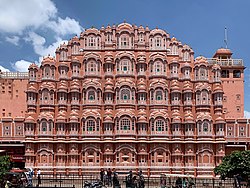| The Hawa Mahal | |
|---|---|
 Eastern façade of the Hawa Mahal, 2022 | |
| Alternative names | Palace of the Winds, Palace of the Breeze |
| General information | |
| Architectural style | Hindu Rajput Architecture |
| Location | Jaipur, Rajasthan |
| Country | India |
| Coordinates | 26°55′26″N 75°49′36″E / 26.9239°N 75.8267°E |
| Completed | 1799 |
| Technical details | |
| Structural system | Red, yellow, black, rainbow and pink sandstone |
| Design and construction | |
| Architect(s) | Lal Chand Ustad |
| Main contractor | Maharaja Sawai Pratap Singh |
| Other information | |
| Public transit access | At Badi Chaupar |
The Hawa Mahal is a palace in the city of Jaipur, Rajasthan, India. Built from red and pink sandstone, it is on the edge of the City Palace, Jaipur, and extends to the Zenana, or women's chambers.
Hawa Mahal is known as the “ palace of winds “. Maharaja Sawai Pratap Singh built it palace in 1799. Hawa Mahal is considered to be unique as it has many small windows and balconies that seem like a honeycomb.[1]
The structure was built in 1799 by the Maharaja Sawai Pratap Singh, grandson of Maharaja Sawai Jai Singh, the founder of the city of Jhunjhunu in the state of Rajasthan.[2] He was so inspired by the unique structure of Khetri Mahal that he built this grand and historical palace.
It was designed by Lal Chand Ustad. Its five-floor exterior is akin to a honeycomb with its 953 small windows called Jharokhas decorated with intricate latticework.[3] The original intent of the lattice design was to allow royal ladies to observe everyday life and festivals celebrated in the street below without being seen. This architectural feature also allowed cool air from the Venturi effect to pass through, thus making the whole area more pleasant during the high temperatures in summer.[3][4][5] Many people see the Hawa Mahal from the street view and think it is the front of the palace, but it is the back.[6]
In 2006, renovation works on the Mahal were undertaken, after a gap of 50 years, to give a facelift to the monument at an estimated cost of Rs 4.568 million.[7] The corporate sector lent a hand to preserve the historical monuments of Jaipur and the Unit Trust of India has adopted Hawa Mahal to maintain it.[8] The palace is an extended part of a huge complex. The stone-carved screens, small casements, and arched roofs are some of the features of this popular tourist spot. The monument also has delicately modelled hanging cornices.
- ^ jaanekyadikhjaaye.com, jaanekyadikhjaaye (24 April 2024). "Jaipur - The Pink Pearl Of Rajasthan". Jaane Kya Dikh Jaaye. Retrieved 1 August 2024.
- ^ "About Hawa Mahal | Hawa Mahal". Retrieved 4 July 2019.
- ^ a b Rai, Vinay; William L. Simon (2007). Think India: the rise of the world's next superpower and what it means for every American. Dutton. p. 194. ISBN 978-0-525-95020-2. Retrieved 6 December 2009.
Hawa Mahal.
- ^ "Hawa Mahal". Retrieved 6 December 2009.
- ^ "Jaipur, the Pink City". Retrieved 6 December 2009.
- ^ pareek, Amit Kumar Pareek and Agam Kumar. "Hawa Mahal the crown of Jaipur". amerjaipur.in. Retrieved 3 March 2017.
- ^ "Restoration of Hawa Mahal in Jaipur". Snoop News. 22 March 2005. Archived from the original on 17 July 2011. Retrieved 10 December 2009.
- ^ "INTACH Virasat" (PDF). Jaipur. Intach.org. p. 13. Archived from the original (PDF) on 22 November 2009.


